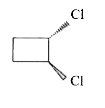Which of the following compounds is optically active?




The correct Answer is:D
To determine which of the given compounds is optically active, we need to identify if any of them are chiral. A compound is chiral if it does not have any plane of symmetry. Here’s a step-by-step solution:
Step 1: Understand the Concept of Chirality
- Chirality: A molecule is chiral if it cannot be superimposed on its mirror image. This typically occurs when a molecule has four different substituents attached to a carbon atom, leading to non-superimposable mirror images.
- Plane of Symmetry: A plane that divides a molecule into two mirror-image halves. If a molecule has a plane of symmetry, it is achiral.
Step 2: Analyze Each Compound
- Compound A:
- It has chlorine (Cl) and bromine (Br) on wedge bonds.
- If we draw a plane that bisects the molecule, we find that the two halves are mirror images of each other.
- Conclusion: It has a plane of symmetry and is achiral.
- Compound B:
- Similar to Compound A, it has Cl on a wedge and Br on a dash.
- A plane can also be drawn that bisects this molecule, resulting in two halves that are mirror images.
- Conclusion: It has a plane of symmetry and is achiral.
- Compound C:
- This compound has two Cl atoms on wedge bonds.
- A plane can be drawn that bisects the molecule, reflecting one half onto the other.
- Conclusion: It has a plane of symmetry and is achiral.
- Compound D:
- This is a cyclobutane with Cl on a wedge and Cl on a hash.
- No plane can be drawn that divides the molecule into two mirror-image halves.
- Conclusion: It does not have a plane of symmetry and is chiral.
Step 3: Identify the Optically Active Compound
- Based on the analysis, Compound D is the only compound that is chiral and therefore optically active.
Final Answer
- The correct answer is Compound D.
- Chirality: A molecule is chiral if it cannot be superimposed on its mirror image. This typically occurs when a molecule has four different substituents attached to a carbon atom, leading to non-superimposable mirror images.
- Plane of Symmetry: A plane that divides a molecule into two mirror-image halves. If a molecule has a plane of symmetry, it is achiral.
- Compound A:
- It has chlorine (Cl) and bromine (Br) on wedge bonds.
- If we draw a plane that bisects the molecule, we find that the two halves are mirror images of each other.
- Conclusion: It has a plane of symmetry and is achiral.
- Similar to Compound A, it has Cl on a wedge and Br on a dash.
- A plane can also be drawn that bisects this molecule, resulting in two halves that are mirror images.
- Conclusion: It has a plane of symmetry and is achiral.
- This compound has two Cl atoms on wedge bonds.
- A plane can be drawn that bisects the molecule, reflecting one half onto the other.
- Conclusion: It has a plane of symmetry and is achiral.
- This is a cyclobutane with Cl on a wedge and Cl on a hash.
- No plane can be drawn that divides the molecule into two mirror-image halves.
- Conclusion: It does not have a plane of symmetry and is chiral.
- Based on the analysis, Compound D is the only compound that is chiral and therefore optically active.
- The correct answer is Compound D.
Similar Questions
Knowledge Check
Which of the following compound is optically inactive ?
ACH3⋅CHOH⋅CH2⋅CH3BH2C=CH⋅CH2⋅CH=CH2C D
D
Which of the following compounds is optically inactive?
A B
B C
C D
D
Which of the following compounds are optically inactive but exhibit geometrical isomerism?
A B
B C
C D
D
Which of the following compounds can be optically active?

Select correct answer using the codes given :
View SolutionWhich of the following biphenyls is optically active?
View SolutionWhich one of the following compounds show optical activity ?
View SolutionWhich of the following compounds will be optically active?
View SolutionWhich of the following compounds loses optical activity due to pyramidal inversion?
View Solution

